Workshop 2
Let's get in touch with the hardware stuff
Content
- The basics about firmware flashing
- Flash ICs
- Write protection mechanisms
- Programmers
- Flash layout
- IFD
-
FMAP
-
Hands-on: Dumping the vendor firmware
-
Hands-on: Flashing the BIOS region
-
The Wedge100s
-
Build coreboot for fsp_broadwell_de
-
Hands-on: Build coreboot for wedge100s
-
Hands-on: Run coreboot on wedge100s
-
Content
- Debugging
- Serial console
- CBMEM console
- EHCI debug
- SPI console
- GDB in QEMU
- GDB in coreboot
- Speakermodem
- Serialice
- Postcode
-
Debugging techniques on Wedge100s
- Payloads
- Choosing the right payload
- Payload types
- Libpayload
- Native Graphics Init
- Hands-on: SeaBIOS with secondary payload
- Hands-on: TianoCore
- Hands-on: LinuxBoot with systemboot
Flash ICs
How do they look like ?

CC-by-SA Raimond Spekking

CC-by-SA Tobias ToMar Maier
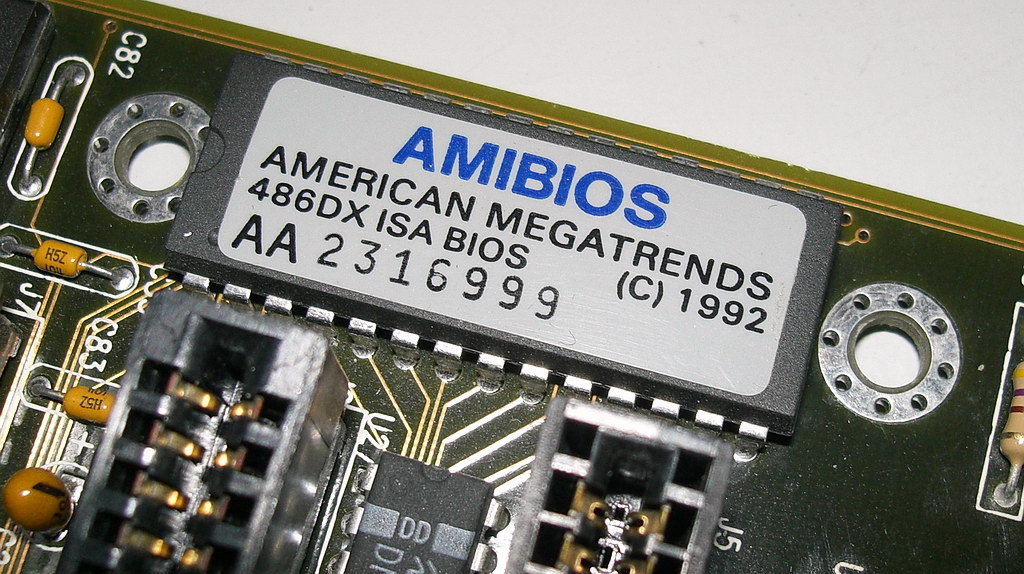
CC-by-SA MOS6502
Flash ICs
- Typical SPI / QSPI
- SOIC-8 and WSON-8 common packages
- Easily identified by colored point on the chip
- 3.3V, 2.5V and 1.8V
1980
Today
64KB
512KB
4MB
16MB
512MB
-
Vendor specific
- instructions
- page size
- block size
- #blocks
- software write protection
- erasure time
- OTP
Write protection
hardware based

Write Protection
software based
SPI controller
SPI flash
SMM
- Protected region
- Volatile
- Flash independent
- Protected region
- (Non)volatile
- Vendor specific
- BIOS_CNTL
- PRR (Protected Range Registers)
Write Protection
hardware write protection on Chromebooks

-
WP-Screw
- Battery powered latch
- EC
Programmers
- No external components
- Running Operation System
- Recovery mechanism
- Transparent flash IC
- Very fast
internal
external
- Needs external components
- Hardware might interfere
- Voltage / current limits
- Support for flash IC
- Slower
- No recovery needed
Programmers
internal
external
Baseboard Management Controller
- Only on server platforms
- Recovery mechanism
- Very fast
- High external component count
- Also allows Serial-over-LAN
- Good for debugging and testing
External Programmers
SF100
- https://www.dediprog.com/product/SF100
- SPI programmer
- HighSpeed USB interface
- +94 sec for 16MiB flash

CC-By-SA Patrick Rudolph
External Programmers
for developers: EM100Pro
- Expensive
- https://www.dediprog.com/product/EM100Pro
- FPGA that emulates common SPI ASICs
- High speed USB interface
- Disables in-circuit SPI flash
- Uploads 16MiB in 3 seconds


CC-By-SA Patrick Rudolph
CC-By-SA Patrick Rudolph
External Programmers
for hackers: Raspberry PI
- Native SPI interface
- Ethernet
- Uploads 16MiB in 10 seconds
- GPIOs / UARTs / I2C
- Short circuit might cause the CPU to reboot

CC-By-SA Patrick Rudolph
External Programmers
buspirate and SPI compatible
- Cheap
- Bit bang mode (1 bit per USB transaction)
- Very slow
- Very slow !
- Uploads 16MiB in +30 minutes
External Programmers
wiring


-
Not safe to use external power supply
- Try to use S3 resume or WOL
- Might power the SoC
- SoC might missbehave or read from flash ...
- Make sure voltages are OK
- Safe to apply external power
- Doesn't power SoC
External Programmers
rules for wiring
- Make sure pinout is correct
- Make sure voltage is correct
- Use a current limited power supply
- Start with low frequencies
- Use short wires
flashrom
general
- flash programmer interface tool
- Developed by Carl-Daniel Hailfinger and Stefan Tauner for a long time
- Now David Hendricks and Nico Huber are the core developers
- https://review.coreboot.org/flashrom.git
- Supports
- 476 flash chips
- 291 chipsets
- 500 mainboards
- 79 PCI devices
- 17 USB devices
- various parallel/serial port-based programmers.
flashrom
advice reading firmware
- Make sure no other bus master is active
- Make sure not to power the whole board
- Read twice and compare the BLOBs
- Try to lower frequency on transmission errors
- Do not use ATX power supplies
Hands-on: Dumping the vendor firmware
Hands-on: Dumping the vendor firmware
Task:
- Connect to OpenBMC on wedge100s
- Enable the SPI interface
- Route SPI to flash IC
- Run flashrom
- Cleanup
- Set boot from ext. flash
What you need:
- A wedge100s
- SSH credentials for the OpenBMC
20min
Hands-on: Dumping the vendor firmware
Preparations for flashing:
$ source /usr/local/bin/openbmc-utils.sh
$ devmem_set_bit $(scu_addr 70) 12
$ gpio_set COM6_BUF_EN 0
$ gpio_set COM_SPI_SEL 1
$ [ -c /dev/spidev5.0 ] || mknod /dev/spidev5.0 c 153 0
$ modprobe spidev
Hands-on: Dumping the vendor firmware
Using flashrom:
$ flashrom -V -p linux_spi:dev=/dev/spidev5.0 ...
$ ... -r firmware.bin
$ ... -w firmware.bin
Hands-on: Dumping the vendor firmware
Clean up after flashing:
$ source /usr/local/bin/openbmc-utils.sh
$ devmem_set_bit $(scu_addr 70) 12
$ gpio_set COM6_BUF_EN 1
$ gpio_set COM_SPI_SEL 0
Hands-on: Dumping the vendor firmware
Boot from ext flash:
$ source /usr/local/bin/openbmc-utils.sh
$ gpio_set BRG_COM_BIOS_DIS0_N 1
$ gpio_set BRG_COM_BIOS_DIS1_N 0
$ gpio_set COM_SPI_SEL 0
$ wedge_power.sh reset
Hands-on: Dumping the vendor firmware
Just copy the scripts:
$ git clone git@github.com:zaolin/FB-Workshop-Samples.git $ cd FB-Workshop-Samples/wedge100s/scripts/
Run doit.sh:
$ ./doit.sh -r firmwaredump.rom
Hands-on: Dumping the vendor firmware
Verify what you got:
$ cd coreboot/util/ifdtool $ make $ ./ifdtool -d firmwaredump.rom
...
Found Region Section
FLREG0: 0x00000000
Flash Region 0 (Flash Descriptor): 00000000 - 00000fff
FLREG1: 0x0bff0500
Flash Region 1 (BIOS): 00500000 - 00bfffff
FLREG2: 0x04ff0003
Flash Region 2 (Intel ME): 00003000 - 004fffff
FLREG3: 0x00020001
Flash Region 3 (GbE): 00001000 - 00002fff
FLREG4: 0x00001fff
Flash Region 4 (Platform Data): 00fff000 - 00000fff (unused)
...
Hands-on: Dumping the vendor firmware
Flash layout on x86

- IFD contains flash layout
- Multiple bus masters!
- Southbridge multiplexes access
- Southbridge supports up to two flash ICs
- One partition for each Coprocessor
- ME >> BIOS
IFD - Intel Flash Descriptor
- Supported since ICH7
- Flash layout
- Access permissions
- Flash special instructions
- OEM section
- Number of flash ICs
- Maximum SPI bus clock
- PCH straps like HAP bit
- Required to boot a PC
IFD - Intel Flash Descriptor
but ...
- No support for fine-grained updates
- Vendor specific
- Layout might change in the future
- Not under firmware control
Hands-on: Flashing the BIOS region
Task:
- Dump firmware layout of existing firmware
- Rewrite firmware into BIOS section of IFD
What you need:
- coreboot
ifdtool - Wedge100s scripts
- Wedge100s firmware dump
5min
Hands-on: Flashing the BIOS region
Hands-on: Flashing the BIOS region
$ util/ifdtool/ifdtool -f layout dumpedfirmware.rom
Extract the layout from IFD:
Use the layout in flashrom:
$ ./doit.sh -w dumpedfirmware.com -l layout -i bios
Starting with flashrom 1.0:
$ ./doit.sh -w dumpedfirmware.com --ifd -i bios
FMAP - Flashmap
- Developed by google in 2015
- Vendor independent flash layout
- Each region has multiple subregions
- Converted by fmaptool
- Can be referenced in coreboot
- Build time sanity checks
- Patches for flashrom pending
HOST_FIRMWARE@0xff800000 8M {
SI_ALL@0 2M {
# Firmware Descriptor section of the Intel
# Firmware Descriptor image.
SI_DESC 4K
# Intel Management Engine section of the Intel Firmware
# Descriptor image.
SI_ME 1,9M
}
SI_BIOS@2M 6M {
RW_SECTION_A@0 0xf0000 {
# Alignment: 4K (for updating) and must be in
# start of each RW_SECTION.
VBLOCK_A 64K
FW_MAIN_A
RW_FWID_A 64
}
RW_SECTION_B@0xf0000 0xf0000 {
...
}
FMAP - Flashmap

IFD vs FMAP
Flashing a single FMAP region
- Patches to support FMAP in flashrom are pending
- https://review.coreboot.org/c/flashrom/+/23203
- Adds the --fmap option
$ flashrom --fmap -i RW_SECTION_B -w coreboot.rom
Build coreboot for fsp_broadwell_de
- You need BLOBs
- Some are not redistributable
- You have to contact Intel or download the Intel FSP from their Github homepage
- Or dump them from your hardware
-
Use flashrom -r backup.rom to read the full image
-
Use ifdtool -x backup.rom to extract Intel IFD and Intel ME
-
-
Copy BLOBs to 3rdparty
-
Integrate them into the build
Build coreboot for fsp_broadwell_de
- You need Intel FSP 1.0
- https://github.com/IntelFsp/FSP
- Redistributable since 23th Aug 2018
- Not integrated into coreboot build system (yet)
- Configuration values are binary patched into the BLOB
Supports runtime configuration using UPD- Binary patching is done using BCT
- https://github.com/IntelFsp/BCT
- Supports
Fedora 24and Windows - Use WINE on Linux
- Needs ABSF which holds the configuration values
FSP 1.0

FSP 2.0

Build coreboot for fsp_broadwell_de
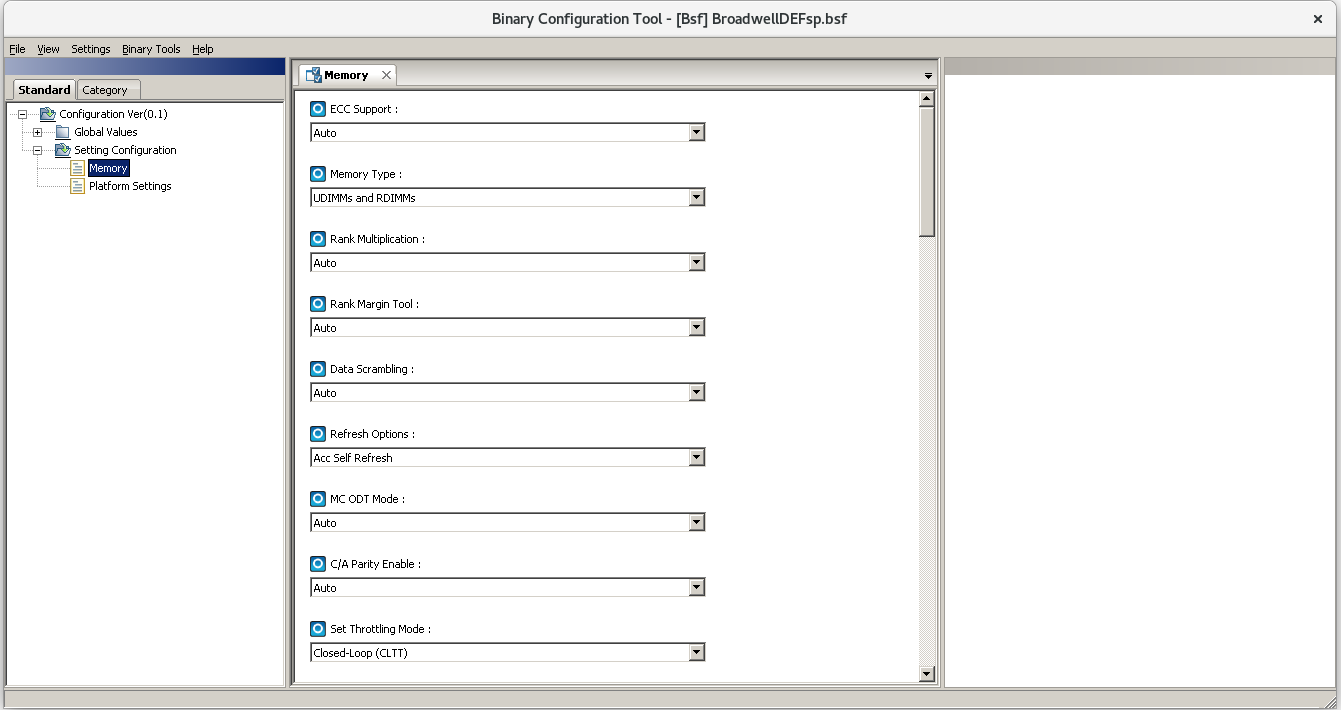
Build coreboot for fsp_broadwell_de
- You need microcode updates
- Intel changed the license a few times
- Redistributable since 23rd Aug 2018 (again)
- The format changed from binary to the header in the past
- Documentation on all sites could be improved
- Without Microcode updates, nothing works!!!
Hands-on: Build coreboot for wedge100s
Hands-on: Build coreboot for wedge100s
Task:
- Select mainboard OCP > weedge100s
- Set path to FMAP
- Select
- Use Intel Firmware Support Package
- Add Intel descriptor.bin file
- Add Intel ME/TXE file
- Include external microcode header files
- Set console
baudrate to 576000
What you need:
- BLOBs
- Intel ME
- Intel IFD
- microcode headers
- FSP 1.0
45min
Hands-on: Build coreboot for wedge100s
Get the blobs:
- Select mainboard OCP > weedge100s
- Set path to FMAP: src/mainboard/ocp/wedge100s/board.fmd
Set the following path in menuconfig:
-
git clone git@github.com:zaolin/FB-Workshop-Samples.git
- Copy BLOBs from FB-Workshop-Samples/wedge100s/blobs/ to 3rdparty/
- Set path to Intel FSP: 3rdparty/wedge100s_broadwelldefsp.rom
- Add Intel descriptor.bin file: 3rdparty/wedge100s_fd.bin
- Add Intel ME/TXE file: 3rdparty/wedge100s_me.bin
Or extract them from the existing blobs
and go the hard way ;)
Hands-on: Build coreboot for wedge100s
-
$ git clone git@github.com:zaolin/FB-Workshop-Samples.git
- Copy headers from FB-Workshop-Samples/wedge100s/microcode/ to 3rdparty/
- Select "Include external microcode header files"
- Set path to microcode headers 3rdparty/ ...
Get the microcode headers:
Build the coreboot.rom:
- Save settings in menu config
- run make
Hands-on: Run coreboot on wedge100s
Hands-on: Run coreboot on wedge100s
Task:
What you need:
- coreboot.rom build for wedge100s
- SSH credentials for OpenBMC
- Copy coreboot to OpenBMC /tmp folder
- Flash the coreboot.rom
- Reboot the main CPU
- Watch the serial console
10min
Hands-on: Run coreboot on wedge100s
Reset main CPU:
Flashing coreboot on wedge100s:
$ ./doit.sh -l layout -i bios -w /tmp/coreboot.rom
$ /usr/local/bin/wedge_power.sh reset
Start serial terminal to verify that it worked:
$ sol.sh
Debugging
Serial console
- I/O based or memory mapped 8250 UART on x86
- memory mapped PL011 on ARM
- Supports SMM debugging
- Most platforms support serial from bootstage
- Some don't and need BLOBs for UART:
- Qualcomm
- Intel's Broadwell_de (and wedge100s)

CC by SA 3.0 AFrank99
CBMEM console
- Immutable after coreboot
- SMM doesn't support CBMEM console
- Single producer
- Lock free
- Implemented as ring buffer
- Might survive hot reset
- Shows contents of last boot
- Readable using
- $ cbmem tool
- /sys/firmware/log
- Supported by SeaBIOS/TianoCore

EHCI Debug
- Only supported on EHCI USB controllers
- Needs a special USB client "debug gadget"
- Supports only High-Speed USB clients
- 480 MBit/s
- 8 byte / BULK transfer
- Much faster than serial
- Only supported in coreboot / Linux kernel
- Doesn't work in bootstage, SMM, libpayload, SeaBIOS...
- Must enable EHCI driver and console redirect to EHCI !

not sold any more

FT2232H + FT2232H + lunch box + tape = 30 €
EHCI Debug

EHCI Debug

SPI console
- Writes to SPI flash
- Not a ring buffer, it stops when buffer is full
- volatile
- Need to be dumped using flashrom
- Only for debugging !
- Needs support in FMAP
- Needs SPI driver in coreboot
- Works in SMM
SPI console
HOST_FIRMWARE@0xff800000 8M {
SI_ALL@0 2M {
# Firmware Descriptor section of the Intel
# Firmware Descriptor image.
SI_DESC 4K
# Intel Management Engine section of the Intel Firmware
# Descriptor image.
SI_ME 1,9M
}
SI_BIOS@2M 6M {
RW_SECTION_A@0 0xf0000 {
# Alignment: 4K (for updating) and must be in
# start of each RW_SECTION.
VBLOCK_A 64K
FW_MAIN_A
RW_FWID_A 64
}
CONSOLE@0xf0000 0x10000
...
}
Add CONSOLE to your RW FMAP:
SPI console
Extract console from dump:
$ flashrom -V -p linux_spi:dev=/dev/spidev5.0 -r dump.rom
Read complete firmware image using flashrom:
$ ./util/cbfstool/cbfstool dump.rom read -r CONSOLE -f spiconsole.log
Boot SPI console enabled device
Shut it down
GDB Qemu on X86
- coreboot generates .debug files in build/cbfs/fallback/
-
Stages can be relocatable
-
If stage is relocatable:
-
stage is placed in CBMEM
-
S3 resume will load ramstage from CBMEM
-
add an offset to symbol file when starting gdb
-
Wrote coreboot table at: 00000500, 0x10 bytes, checksum efe3 Writing coreboot table at 0x7ffa9000 0. 0000000000000000-0000000000000fff: CONFIGURATION TABLES 1. 0000000000001000-000000000009ffff: RAM 2. 00000000000c0000-000000007ff83fff: RAM 3. 000000007ff84000-000000007ffb1fff: CONFIGURATION TABLES 4. 000000007ffb2000-000000007ffddfff: RAMSTAGE 5. 000000007ffde000-000000007fffffff: CONFIGURATION TABLES 6. 00000000b0000000-00000000bfffffff: RESERVED
coreboot log:
GDB Qemu on X86
$ gdb
(gdb) add-symbol-file build/cbfs/fallback/ramstage.debug 0x7ffb2000
add symbol table from file "build/cbfs/fallback/ramstage.debug" at
.text_addr = 0x7ffb2000
(y or n) y
(gdb) b main
Breakpoint 1 at 0x60030f80: file src/lib/hardwaremain.c, line 438.
(gdb) target remote localhost:1234
$ qemu-system-i386 -m 1024 -S -s -bios build/coreboot.rom -M q35
Start qemu and wait for gdb connection:
Start gdb and connect to qemu:
GDB Qemu on ARM
$ gdb build/cbfs/fallback/ramstage.debug (gdb) b main Breakpoint 1 at 0x60030f80: file src/lib/hardwaremain.c, line 438. (gdb) target remote localhost:1234
$ qemu-system-arm -m 1024 -S -s -bios build/coreboot.rom -M vexpress-a9 -nographic
Example with non relocatable ramstage on ARM vexpress-a9:
GDB in coreboot
- x86 only
- halts on
ramstage entry or on exception - GDB 8.0+ compatible
- doesn't work on wedge100s
- GDB 7 on
OpenBMC
- GDB 7 on
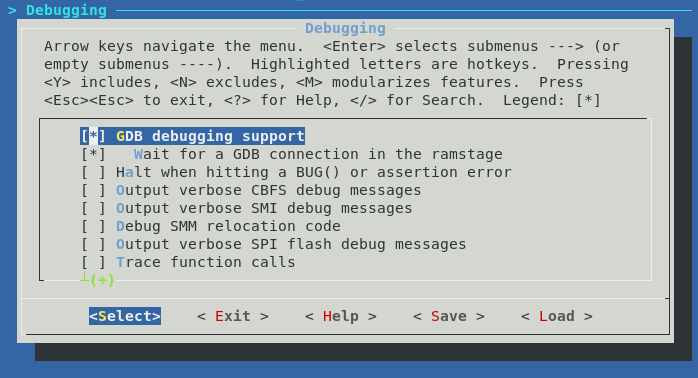
Speakermodem
- x86 only
- frequency modulated PIT timer
- You need a microphone and application to decode the tone
- Very slow

Serialice
- x86 only
- blackbox tracing of arbitrary firmware
- no reverse engineering of copyright protected BLOBs
- RS232 only
Serialice
- serialice shell runs on real hardware
- firmware under test runs in QEMU
- lua scripts intercept all I/O
- redirects some of the I/O to "real" hardware using serialice shell
- all I/O is captured

POST codes

- Legacy x86
- Very basic
- Only gives a hint what did go wrong
Debugging techniques on wedge100s
- Serial console
- SPI console
- CBMEM console
- morse code on LEDs (currently not upstream)
Payloads
Payload types
- Static ELF binaries
- Flat binaries
- bzImage
- uImage (FIT)
- libpayload based
Static ELF binaries
- Converted to Simple ELF (SELF) by cbfstool
- Fixed position in physical address space
- Not relocatable
- SELF segments can be compressed
- Possible payloads:
- SeaBIOS
- GRUB
- Tianocore
- depthcharge
- memtest86+
Flat binaries
- Simple entry point
- No conversion
- Supported payloads:
- uboot
bzImage
- x86 only
- Is already compressed
- Requires trampoline code
- Follows Linux aarch64 calling conventions
- Has a special loader
- vmlinux, vmlinuz, Image isn't supported
bzImage
- Graphics init in coreboot is optional
- Graphics init in kernel is done late
- No BIOS or EFI services
- Flash as size limitation
- Kernel update requires flashing a new firmware
but ...
uImage (FIT)
- ARM64 only
- Multiple sections (kernel, initrd, devicetree, config, ...)
- Has optional compression
- Includes a DTB
- Follows Linux aarch64 calling conventions
- Has a special loader
libpayload
- Bare metal library used by some payloads
- Custom USB driver
- Custom PS/2 driver
- Simple framebuffer driver
- Understands CBFS/CBMEM/CBTABLES ...
- Provides basic libc functions
- ASM stub, payload can be written in pure C
libpayload
-
Don't expect anything
- No FPU initialized
- No SSE enabled
- Single threaded
- No interrupts
- Has to deal with hardware bugs
- No filesystem drivers
- on x86 32-bit protected mode only
- Single threaded
- No ACPI support
- Simple powermangement in the works
- No filesystem driver
but ...
libpayload
- depthcharge
- nvramcui
- tint
- coreinfo
Payloads that use libpayload
Native graphics init
- 64 KiB VGA Option ROM BLOB
- 16-bit x86 instructions
- No signature
- Optional YABEL emulator in coreboot
- not redistributable
Situation in comercial BIOS:
Situation in comercial EFI:
- GOP driver BLOB
- Signed code
- Can't be run in coreboot
- not redistributable
Community efforts in coreboot:
- Reverse engineered graphics init using YABEL
- Only for integrated LVDS panels
- Only for some panels ...
Native graphics init
- Written in ADA SPARK
- Supports all platforms starting from gm45
- Supports all connector types
Replaced by libgfxinit on x86:
- Requires coreboot support in the payload or OS
- No resolution switching at runtime
- Can be skipped if payload does graphics init
- SeaBIOS using VGA Option ROM
- TianoCore using GOP driver
- Linux using KMS and VBT
In general:
coreboot framebuffer info
- Provides a framebuffer base address and metadata
- Only readable by payloads that know about coreboot
- No support in Microsoft/Apple
- Payloads that support reading the framebuffer info:
- Libpayload
- GRUB
- SeaBIOS
- TianoCore
- GNU/Linux
#define LB_TAG_FRAMEBUFFER 0x0012
struct lb_framebuffer {
uint32_t tag;
uint32_t size;
uint64_t physical_address;
uint32_t x_resolution;
uint32_t y_resolution;
uint32_t bytes_per_line;
uint8_t bits_per_pixel;
uint8_t red_mask_pos;
uint8_t red_mask_size;
uint8_t green_mask_pos;
uint8_t green_mask_size;
uint8_t blue_mask_pos;
uint8_t blue_mask_size;
uint8_t reserved_mask_pos;
uint8_t reserved_mask_size;
};
SeaBIOS
- x86 only
- CSM for TianoCore
- Supports secondary payloads
- coreinfo
- tint
- nvramcui
- memtest86
- Build using coreboot toolchain
- payloads stored in CBFS
- loaded by a payload
secondary payloads:
- Only text menu
- Runs unsigned Option ROMs
- BIOS services are
16bit real mode - No Secure Boot
- Runs unsigned code from MBRs
- No mouse support
- CSM for TianoCore
- Build using coreboot toolchain
- TPM support
- PS/2 driver
- Provides all common 16bit BIOS services
- SeaVGABios for "Native graphics Init"
facts
SeaVGABios
- 16bit VGA Option ROM
- Provides VBE 2.0 interface
- Advertises
coreboot's framebuffer info - No mode switching
- No legacy VGA modes
- RGB8 pallette only
-
Code doesn't interact with hardware - Legacy application do work with
coreboot's graphics init
facts
Hands-on: Build SeaBIOS with secondary payloads
Task:
What you need:
Hands-on: Build SeaBIOS with secondary payloads
- coreboot firmware for the wedge100s
- Select ocp > wedge100s as mainboard
- Select SeaBIOS master as payload
Enable secondary payloads
- Run coreinfo, nvramtool and memtest86+
- Enable sercon with the right address in the SeaBIOS payload section
15min
Hands-on: Build SeaBIOS with secondary payloads

Hands-on: Build SeaBIOS with secondary payloads

Hands-on: Build SeaBIOS with secondary payloads
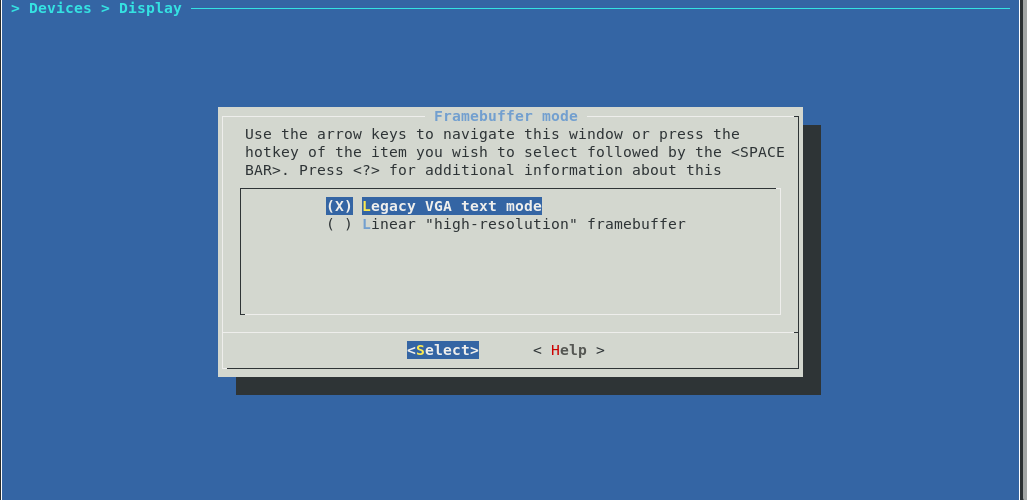
Note: memtest86 is VGA text mode only
Hands-on: Build SeaBIOS with secondary payloads

Note: CMOS support is needed by sub-payloads

TianoCore
- Intel Open Source UEFI reference implementation
- Integrated into x86 coreboot build system
- Only graphical menu
- SeaBIOS as CSM
- Build using an external toolchain
- Includes CorebootPkg
- No Secure Boot support yet for coreboot
- No persistent NVRAM support for coreboot
Hands-on: Build Tianocore in QEMU
Task:
- Select mainboard emulation > qemu-q35
- Select Tianocore as payload in menuconfig
- Select "High-resolution" framebuffer in menuconfig
- Delete a patch to enable serial output in Tianocore
What you need:
(No Blobs)
15min
Hands-on: Build Tianocore in QEMU
Hands-on: Build Tianocore in QEMU
Select Tianocore as payload and select "debug build":

Hands-on: Build Tianocore in QEMU
Select "high-resolution" frambuffer in Devices > Display :
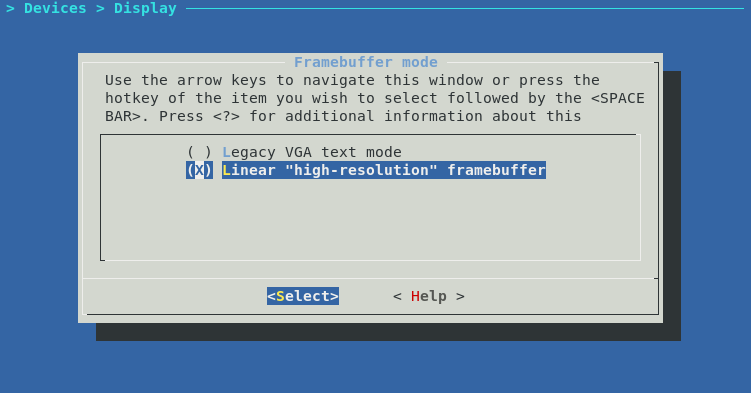
Hands-on: Build Tianocore in QEMU
Remove the file:
$ rm payloads/external/tianocore/patches/05_CorebootPayloadPkg_noserial.patch
Build coreboot.rom
Run it in qemu:
$ make
$ qemu-system-x64_86 -m 2048 -M q35 -bios build/coreboot.rom

LinuxBoot
- The idea of running Linux inside the firmware
- Well tested drivers for anything
- Graphics
- USB
- Input device
- Block devices
- SCSI devices
- Network
- EC/SuperIO
- Easy to write application programs
- You don't need firmware engineers
- Project works with coreboot, UEFI and u-boot
- If you are stuck with non-coreboot OCP HW look into the repository for LinuxBoot UEFI supported boards.
- coreboot integration
- Graphics output via KMS and VBT
- Requires external toolchain (
non x86 - No EFI boot support (yet)
- Big payload size
- Bigger attack surfaces
- Drivers for VPD, CBMEM console
and coreboot framebuffer are available
linuxboot.org
u-root
- Golang initramfs generator
- Only 4 go binaries
- Has an init system and can start systemd
- Supports source/bb build mode
- Compiles everything into a initramfs.cpio
- Supports libraries aka pkg/*
- Is a coreutils replacement and tools can be found under cmds/*
- Tooling is currently somehow complicated because the use of flags
- Missing Golang kexec implementation for other than x86 but kexecbin is available
u-root.tk
systemboot
- App which runs on top of u-root with custom uinit application
- A LinuxBoot bootloader implementation
- Can run multiple boot commands called booter
- Localboot capability with GRUB2, Syslinux and MBR support
- Netboot capability with DHCP/HTTPS support
- TPM support
- VPD support
- Recoveryhandler support
- RNG seeder support
- Boot Configurations
- Verifiedboot is WIP
systemboot.org
Hands-on:
Build coreboot + LinuxBoot with systemboot
Hands-on: Build LinuxBoot with systemboot
Task:
- Select ocp > wedge100s as mainboard
- Select LinuxBoot as payload
- Set "console=ttyS0,57600" as kernel commandline
- Checkout u-root and systemboot
- Build the initramfs.cpio.xz
- Add systemboot as initramfs.cpio.xz into coreboot
- Build coreboot
What you need:
- coreboot firmware for the wedge100s
- u-root from u-root.tk
- systemboot from systemboot.org
45min
Hands-on: Build LinuxBoot with systemboot

Hands-on: Build LinuxBoot with systemboot
Build u-root
- Install a Go 1.9+ toolchain
- export GOPATH=/path/to/go
- git clone .... /path/to/go/src/github.com/u-root/u-root
- go build u-root.go
Build systemboot
- git clone systemboot into the GOPATH
- cd github.com/u-root/u-root
- GOARCH=amd64 ./u-root -build bb -format cpio -o initramfs.cpio cmds/init path/to/systemboot/netboot/dir path/to/systemboot/localboot/dir path/to/systemboot/uinit/dir
- xz -f --check=crc32 -9 --lzma2=dict=1MiB initramfs.cpio
Hands-on: Build LinuxBoot with systemboot
Configure the kernel
- The coreboot x86 defconfig under payloads/external/LinuxBoot/x86/defconfig should be sufficient if you enable kexec_file_load
- Compile coreboot with LinuxBoot and abort if kernel compilation starts
- cd payloads/external/LinuxBoot/linuxboot/kernel
- ARCH=x86_64 make menuconfig
- make savedefconfig
- cp defconfig ../../x86_64/defconfig
- cd ...
Hands-on: Build LinuxBoot with systemboot

Hands-on: Build LinuxBoot with systemboot
Modify LinuxBoot parameters and build the coreboot image
- Add the kernel command-line parameters under the LinuxBoot payload section in kconfig of coreboot
- console=ttyS0,57600
- Copy our newly generated initramfs.cpio.xz to payloads/external/LinuxBoot/linuxboot/initramfs.cpio.xz
- Run the build with a custom toolchain LINUXBOOT_COMPILE=/your/toolchain make
Hands-on: Build LinuxBoot with systemboot

Test time ;)
10min
Let's get in touch with the hardware stuff
By 9elements Agency GmbH
Let's get in touch with the hardware stuff
- 1,236



